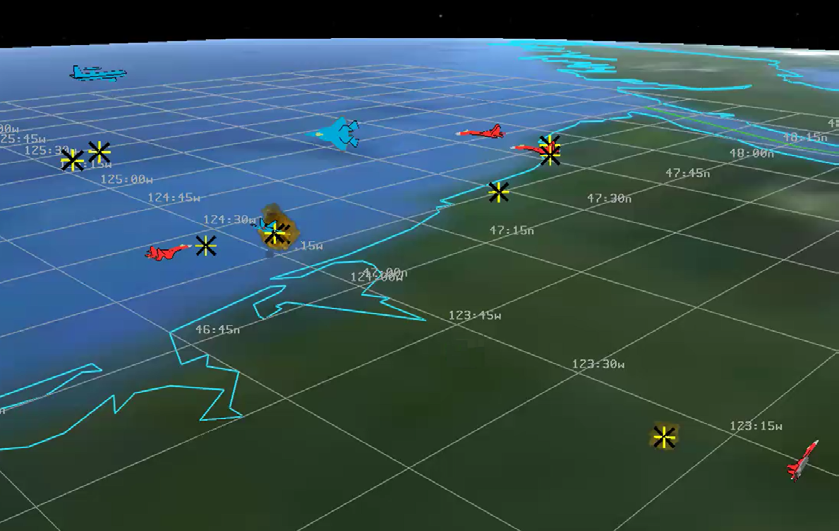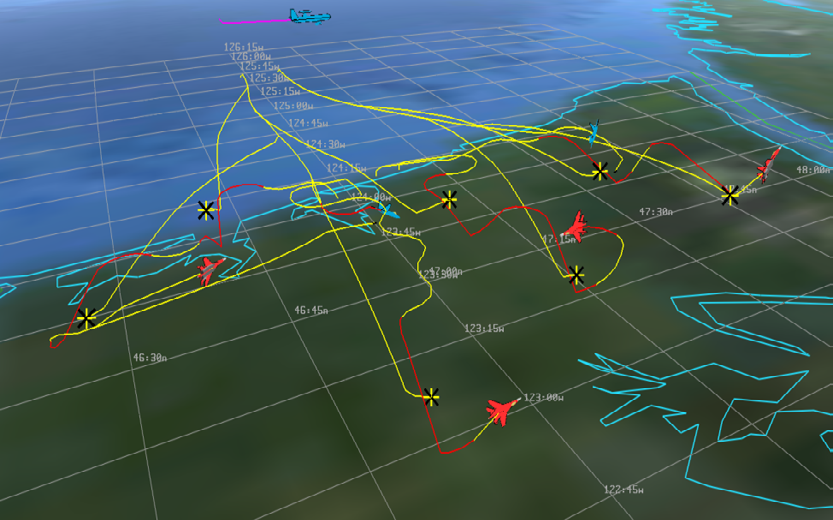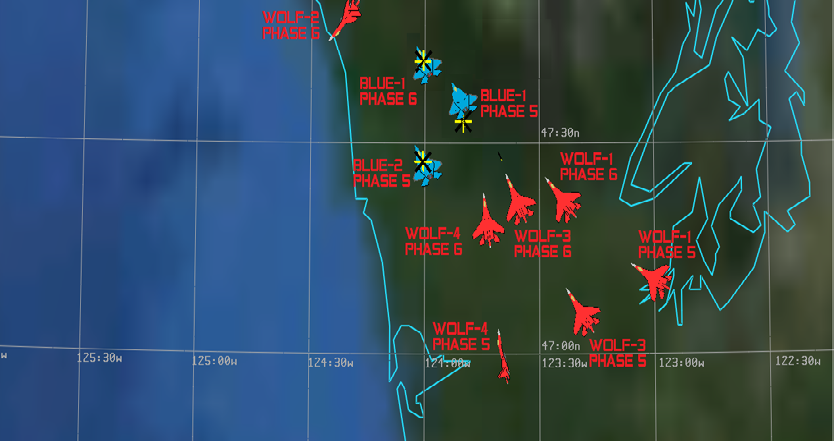AI defeated man in air combat simulation

View from the side during the battle. Badges mark locations of rocket explosions. One of the two blue fighters destroyed, the second left the scene of the battle. All red fighter planes under AI control evaded enemy missiles
Perhaps, in many years, people will send not young men to the war, but computer-controlled unmanned combat vehicles. And not only to save human lives, but also for another reason: because protein intelligence simply can’t oppose sophisticated maneuvers and instant computer reaction.
Engineers continue to improve combat programs to control modern weapons - and have already achieved some success. In recent tests , the Alpha artificial intelligence system, using four virtual fighters, successfully defended the coastline from two attacking fighter planes with superior weapons, which were operated by former US Air Force Colonel Gene Lee. According to some experts, the behavior of the AI, its maneuvers and the outcome of air combat look "promising."

US Air Force Colonel Jin Lee during an Alpha AI battle
')
The Alpha program was developed by a group of specialists from the University of Cincinnati, Psibernetix , a defense company , and the Air Force Research Laboratory.
When it was created, the methods of fuzzy logic were used, namely, the so-called “fuzzy tree” (fuzzy tree) was created using genetic algorithms (Genetic Fuzzy Tree, GFT). Apparently, this is the most suitable approach for processing information in real time and making decisions during air combat.

Fuzzy Tree Layout Example
Fuzzy logic methods have long been studied and applied, but Alpha developers managed to adapt them for real combat missions and show that even a low-budget personal computer worth $ 500 is able to process data in real time and make adequate decisions, defeating professional human pilots.
In aerial combat, modern fighters converge at speeds of more than 2000 km / h (for example, the maximum speed of the F-35 fighter is 1900 km / h, the Su-35 fighter - 2400 km / h). At such speeds, the outcome of the battle is decided by microseconds. Accordingly, the developers of the Alpha program set a goal to use the mistakes of the enemy pilots, and they are inevitable due to the imperfections of the human body, which is simply physically unable to react to events in real time or close to it ). According to the developers, the AI can consider and coordinate the most optimal tactical plan and the trajectories of maneuvers in a dynamic environment 250 times faster than a person can blink .
It is obvious that the coordination of the actions of several fighters is also carried out much faster if they are synchronously controlled by one computer program, and not by several individual pilots who are negotiating on the radio and trying to coordinate their actions.
The Alpha program has repeatedly defeated the human pilots, including giving them a head start in rocket armament, speed, maneuverability and sensors. But here is another matter. Colonel Jin Lee is not just a former professional pilot (he ended his career as an air battle manager - an air battle manager, which is not a traditional pilot), he is one of the world's best specialists in computer simulation fights. A colonel from the 1980s has been participating in such tests, battling with various computer programs that are trying to defeat him.
In the military field, such a victory of the Alpha program is akin to the chess victory of the computer Deep Blue over the grandmaster.
Jin Lee himself was also impressed with the Alpha program: “I’m surprised at how knowledgeable she is and how quickly she reacts,” he said. - She seemed to know about my intentions and instantly reacted to changes in the course and deployment of rockets. She knew how to repel a blow, and instantly went from defensive action to attack if necessary. ”
Jin Lee says that after many hours of gaming sessions against Alpha, he returned home completely exhausted and emotionally exhausted: “It may not be real intelligence, but it represents a worthy opponent,” the American pilot admitted.

Disposition before the start of the battle. The group of fighters under the control of artificial intelligence is marked in red

Maneuvers using the flanks of the red team

The first and second stages of the training mission

The third and fourth stages of the training mission

View of the training mission from the side with traces to the fourth stage

The fifth and sixth stages of the educational mission
In the future, AI systems like this can be used to control real combat fighters and drones, which are now controlled by operators in remote mode.

Military drone with remote control
At first, the use of artificial intelligence will probably be banned by international conventions, as cluster munitions, chemical weapons, biological weapons, napalm, anti-personnel mines, climate weapons and other weapons that give one of the opponents a dishonest advantage are now prohibited.
But history shows that the rules of war are not always respected. It happens that one of the parties is ready to use even dishonest methods of warfare to win. If she uses artificial intelligence, the rest will probably have nothing left but to answer with the same. And then the Third World War threatens to turn into a war of programmers, as the Second World War was in some sense a war of “fighters of the invisible front” - cryptographers and cryptographers who tried to declassify the enemy’s communications, which immediately gave a huge advantage.
But even if the use of AI in real combat would be prohibited, such tools are suitable for training pilots and as auxiliary systems during non-combat operations.
The scientific work with the results of tests of artificial intelligence Alpha was published in the Journal of Defense Management (doi: 10.4172 / 2167-0374.1000144, pdf ).
Source: https://habr.com/ru/post/395525/
All Articles